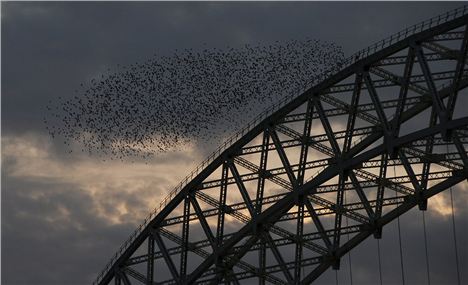The new crossing between Runcorn and Widnes moved a stage closer this week with the announcement a Spanish-led consortium has won the race to build and run it.
Nobody who has queued for hours in the creaking Silver Jubilee Bridge, also known as the world’s biggest bird perch for its starling gatherings, will question the urgent need for a new crossing.
The current single-span arch was opened in 1961 with a capacity of 9,000 vehicles a day. An expensive but modest widening scheme increased this to 15,000 vehicles a day, but today up to 90,000 cars, lorries and buses thunder or crawl across the bridge, depending on circumstances.
 Tolls too on the world's biggest bird perch
Tolls too on the world's biggest bird perch
The bridge is the umbilical chord within Halton, linking the twin towns of Widnes and Runcorn which were forced into an arranged marriage in 1974. Because civic facilities are spread across the borough there is a lot of to-ing and fro-ing over the bridge.
The new bridge, due to open in the first half of 2017, will be a striking andmark costing £600m and will be one of the top 100 urban projects anywhere in the world this decade.
Then you get down to brass tacks, or rather money.
Motorists navigating this six-lane super bridge, known as the Mersey Gateway, will have to pay a toll. No problem! We’ll use the old bridge. No you won’t – that will be tolled as well to prevent freebie crossings.
The talk is of tolls between Runcorn and Widnes mirroring Mersey Tunnel prices, though that is not yet set in sandstone.
It’s not the fault of the council whose hands were tied by a government unwilling to stump up the cost of what is, after all, part of the national road network. They didn’t impose a charge to cross Thelwall Viaduct just up the road.
The only way of funding the Gateway is with some government dosh, but the bulk of the money will come from future tolls during the 30 year lifespan of the consortium.
Churchill
Who can say what will happen in the middle of this century when the contract period ends?
It was after all Winston Churchill who, as the then Minister of Transport, said Birkenhead tunnel tolls would be removed when the debt was paid.
The hope within the corridors of power in Halton is that local residents will be allowed free or cut-price crossing fees.
But there is a word of caution from Halton Labour MP Derek Twigg. He says the intention at the moment is that any profits from tolls will wing their way to the Treasury, rather than locally.
Just looking at simple maths, the bridge could well be a money spinner. Assuming a toll of £2 or just under, and a prediction of 80,000 drivers a day making the crossing, income from tolls could reach around £150,000 A DAY!
Probably much more as HGVs will pay extra. Over the 30 year “span” of the contract period, the tolls would have earned £1.5 billion – and that is assuming the tolls remain unaltered. More likely the earnings over that period will probably be at least be double.
Derek Twigg has vowed to fight the battle in Westminster to win free or low cost travel for his constituents.
Halton, with its much needed bridge, is likely to become the first town in England where people have to pay to move from one part to another.
It’s a far cry from the famous monologue of the Runcorn ferryman, immortalized by Stanley Holloway in “Per tuppence, per person, per trip”.















